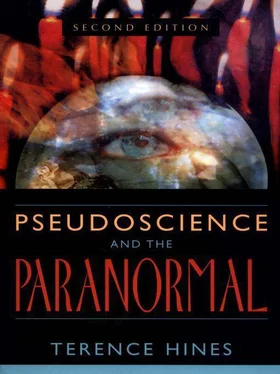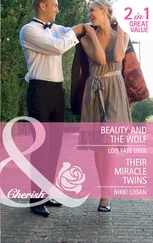DS: Yes, he’s here, looking at the flowers.—“Yes, Daniel, you can, tove”—he says “Can I have some flowers for my mum?” [Audience sighs.] So when you go tonight, lovey, will you take some flowers?
Woman: He wasn’t my baby.
DS: No, but you know his mum.
Woman: Yes.
DS: No, I didn’t say to you… he said, “Can I have some flowers for my Mum, ‘cos she’ll never believe I’m here,” and he’s a beautiful child… Just a minute, Daniel… He had a defect [Woman nods] with his heart, darling, and they tried to repair it, and it didn’t work, but he’s growing up and he’s nearly three he said, and he’s talking away.
Those who believe in Mrs. Stokes’s ability to hear spirit messages from beyond—and there are many—or those who think vaguely that there must be something in it, might be greatly impressed by that exchange. After all, she had scored several hits. The boy had to go back into hospital, he had a heart defect, he had auburn hair, and he would have been three years old. She also got agreement for saying “he’s a beautiful child,” though the woman was hardly likely to reply “No, he was a revolting little brute.”
Horrid old skeptics, such as members of CSICOP, see the exchange slightly differently. It’s a fair assumption that the woman was distressed about the child Daniel, and this would almost certainly imply illness and so a return to hospital. Heart disease is a common killer of infants (and earlier in the same session Mrs. Stokes coped bravely when she wrongly announced that a man had died of a heart attack—he turned out to have died of cancer. “He did have a heart attack at the very end, he tells me,” she riposted. Conveniently, the spirits are sometimes on hand to correct the living).
She is right about the child’s age, and right about his hair color—though neither is particularly surprising. The woman told her he was “very little,” and the description ‘auburn’ could apply to almost any hair except blonde or jet black.
But, most remarkably to a skeptic, she is entirely wrong about the two most important facts of all: in spite of her smooth recoveries, she clearly thinks she is addressing Daniel’s mother and she believes at the start that the child is still alive. Is this because, as she says, that listening to spirit voices is as confusing as listening to five phone conversations at once? Or is it because she was thrown by the woman’s first remark: “I’ve got a Daniel,” in the present tense?
Time and again, Mrs. Stokes is right about a few small details and wrong about the important ones. Sometimes this has hilarious results. “She adored those kids,” she says of a deceased grandmother. “Well, she never actually saw them in this life,” adds the mother, anxious to let her off the hook. Giving a hearing to a bereaved family Mrs. Stokes apparently knows that their lad knew someone called “Gary” (a fairly common name among working-class teenagers) but has to be told that their boy had shot himself. Learning this, she is able to inform them that he was “moody.” (pp. 21–22)
Several self-proclaimed psychics became very popular in the late 1990s. James van Praagh was probably the most widely seen, popping up on numerous TV and radio talk shows, followed by Sylvia Browne. Then there was John Edward, who had his own TV program, Crossing Over, on the Sci-Fi Channel. Several authors (Christopher 2001; Posner 1998; Randi 2000; Shermer 1998) have noted that these three are using nothing more than the standard cold-reading technique, combined in John Edward’s case with a bit of “twenty questions” and a cleaver editing of what viewers see on his TV program. The program that airs is a cut-down version of a much longer studio session. And what airs does not include the numerous misses Edward makes (Jaroff 2001). The viewers see only the amazed reactions of the audience members when he does make a “hit.” Van Praagh also uses a version of the cold-reading technique in which he’ll make a statement (i.e., “I’m getting an image of green dinner plates”) and will then ask “Do you understand?” The answer is almost always “yes” because the person being asked does understand the concept of green dinner plates. But the “yes” is taken by van Praagh, and many people who see or hear him, to mean that green dinner plates were something meaningful or important to the dead person van Praagh is supposedly in contact with.
If John Edward (or any of the other self-proclaimed speakers with the dead) really could communicate with the dead, it would be a trivial matter to prove it. All that would be necessary would be for him to contact any of the thousands of missing persons who are presumed dead—famous (e.g., Jimmy Hoffa, Judge Crater) or otherwise—and correctly report where the body is. Of course, this is never done. All we get, instead, are platitudes to the effect that Aunt Millie, who liked green plates, is happy on the other side.
Shortly after the terrorist attacks of September 11, 2001, Edward taped “readings” with several victims’ families, which he planned to air on a special edition of his television show. Even by Edward’s standards, this was an especially despicable attempt to cash in on the grief of the victims’ families. Fearing it might offend viewers, the producers of Crossing Over scrapped the idea in late October (de Moraes 2001).
Another factor plays an important role in convincing reader and victim that the cold reading is accurate. This is known as the P. T. Barnum effect. It permits victims to believe that a vague stock spiel, with few or no specifics, is an accurate description of their own individual personality. The Barnum effect (so named because the famous quip “There’s a sucker born every minute” is usually attributed to P. T. Barnum. In fact, the phrase didn’t originate with Barnum. Credit should go to an 1880s con man named Joseph Bessimer. [Saxon 1989]) can be demonstrated easily in a classroom. The instructor gives a personality test to each student, telling the class that the test results give an accurate picture of an individual’s personality. About a week after the students have taken the test, they receive typed personality sketches, complete with their names at the top, based on their test responses. Students are then asked to judge how accurate the sketches are as a description of their own, individual, personality and how accurate they would be if applied to the “average” person. Invariably, the sketch is seen as a very accurate portrayal of the individual’s personality, but a very poor portrayal of the personality of the “average” person (Hyman 1976–77). This would be unsurprising, except for one thing: there really was no personality test. All the students were given the same personality sketch, differing only in the name typed at the top of the page. Thus, the belief that the nonexistent personality test is valid results in the acceptance of the sketch as highly accurate, even though all the students rate it as applying to them alone.
Psychics, astrologers, graphologists (who claim to be able to determine personality from handwriting), and tarot card readers all benefit greatly from the Barnum effect. The vast majority of their clients are already, to some extent, believers. Thus, even a vague description that could apply to nearly anyone will be seen as highly specific to the individual. The psychic will then be given credit for amazing, perhaps even paranormal, insights.
Some typical stock spiels that have been shown to be effective illustrate just how vague such statements really are. The following two are taken from Hyman (1976–77) and Snyder and Shenkel (1975), respectively.
You appear to be a cheerful, well-balanced person. You may have some alternation of happy and unhappy moods, but they are not extreme now. You have few or no problems with your health. You are sociable and mix well with others. You are adaptable to social situations. You tend to be adventurous. Your interests are wide. You are fairly self-confident and usually think clearly. (Hyman 1976–77, p. 23)
Читать дальше












